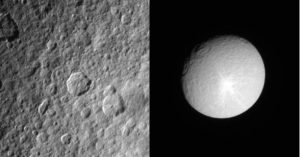Rhea's Ray Crater

One of the features in the new set of Rhea images is a very prominent ray crater. The full ray system is better seen at lower phase angles, like this opnav image from last week. Ray systems often denote fresher craters where the ejecta and secondary craters have not been "eroded" by space weathering. Famous ray craters include Tycho and Copernicus on the Moon, Zunil on Mars, and Cassandra on Dione (lower left). Cassini imaged Rhea's major ray crater at 900 m/pixel on this encounter.


2 Comments:
So - it's that big polygonal one? I was expecting something that would look a bit more obviously fresh. I guess in this case, "fresh" might mean "only" a billion or so years old, so maybe not so fresh after all...
It's the crater at the center of the left framelet. The fact that even "fresh" craters are polygonal (and I assume it is fresh from the rays and the lack of superimposed craters) suggests that something about Rhea's surface is making craters form this way. Perhaps the regolith is thicker than normal. Not being a crater expert, I will have to defer the answer to others but it is certainly a mystery.
Post a Comment
<< Home